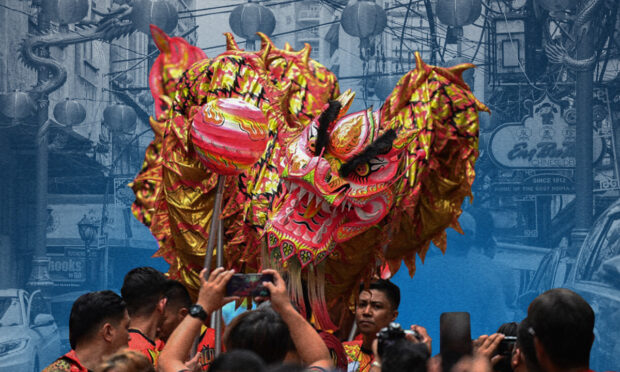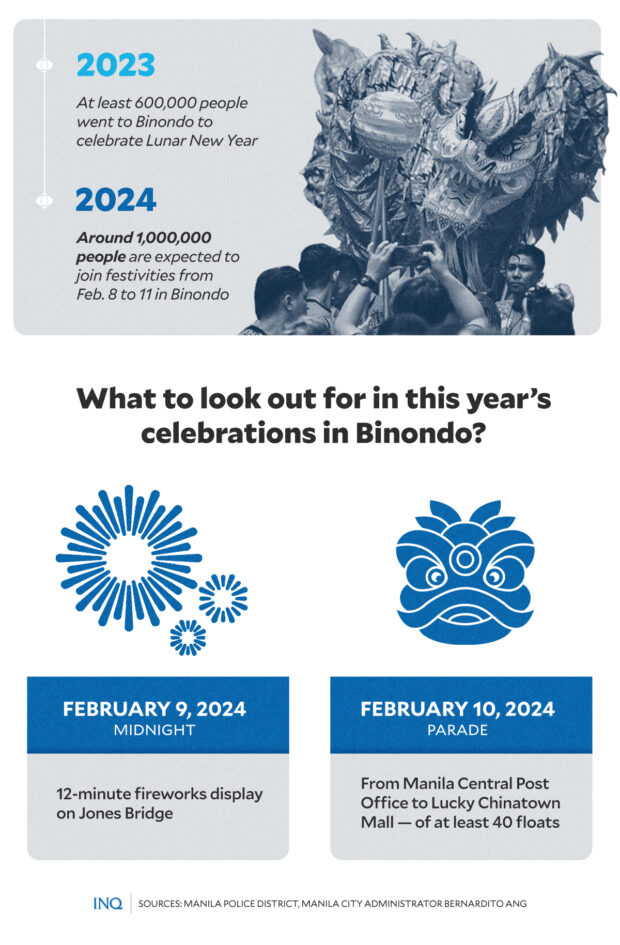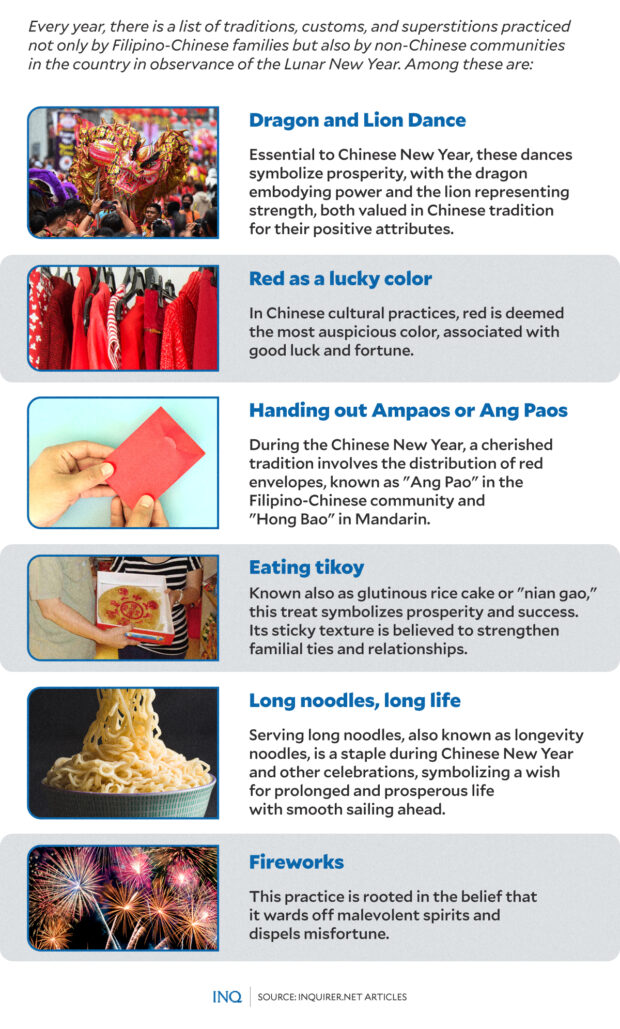What to know about Lunar New Year Celebrations in PH

COMPOSITE IMAGE: AFP FILE PHOTOS
MANILA, Philippines — Lunar New Year is around the corner!
Lunar New Year, an important event celebrated in China and various countries across Asia, is marked by vibrant festivities that begin with the first new moon of the lunar calendar. These celebrations extend for 15 days, culminating on the first full moon of the lunar calendar.
The holiday’s dates shift annually, typically falling between January 21 and February 20, according to the Gregorian calendar.
This celebration is recognized by different names across various regions: in China, it is known as the Chinese New Year or Spring Festival (Chūnjié), in Korea as Seollal, and in Vietnam as Tết. Each of these names reflects the unique cultural identity and traditions with which the festival is celebrated in these countries.
The celebration is characterized by large family reunions, lavish feasts, and practices and superstitions aimed at inviting good fortune and prosperity.
Article continues after this advertisement
GRAPHIC Ed Lustan
Within the framework of the lunar calendar, the Chinese zodiac operates on a cycle of 12 years, with each year being represented by one of twelve distinct animals. This ensures that every year is connected to a specific animal, including the rat, ox, tiger, rabbit, dragon, snake, horse, goat, monkey, rooster, dog, and pig, in alignment with the lunar cycle’s rhythm.
Article continues after this advertisement2024 is the year of the Wood Dragon.
This article by INQUIRER.net will delve into the observance of the Lunar New Year in the Philippines, showcasing a range of traditions available for individuals to engage in as part of celebrations set to take place on February 10 this year.
Lunar New Year in PH
Lunar New Year is celebrated with great enthusiasm in the Philippines, particularly in Filipino-Chinese communities. These vibrant festivities are primarily centered in Manila’s Binondo district, which boasts the distinction of being the world’s oldest Chinatown.
The cultural influence of China has extended beyond those of Chinese descent, leading many Filipino families with no Chinese ancestry to also embrace Lunar New Year traditions. This widespread participation underscores the deep cultural integration and mutual respect between the Filipino and Chinese communities in the country.
The significance of this celebration was formally recognized when then President Benigno “Noynoy” S. Aquino III declared the Chinese New Year a national holiday on February 19, 2015, through Proclamation no. 831.
Aquino highlighted the joint celebration as a testament to solidarity with the Chinese-Filipino community, acknowledging its substantial role and contribution to the nation’s development and history.
READ: Chinese New Year a special nonworking holiday–Palace

GRAPHIC Ed Lustan
Chinese Filipinos, or Tsinoys, have been acknowledged as an integral part of Philippine history, with their presence predating the arrival of the Spaniards in the 16th century. The influx of Chinese immigrants increased in the early 17th century, attracted by the Philippines’ burgeoning economic opportunities.
Recent years have seen a surge in participation in Lunar New Year festivities in Binondo. Last year, the Manila Police District (MPD) reported that approximately 600,000 people gathered to celebrate the occasion.
This year, Manila City Administrator Bernardito Ang anticipates the number to reach around a million from February 8 to 11.
The celebrations are set to include a 12-minute fireworks display on Jones Bridge at midnight on February 9 and a parade featuring at least 40 floats, which will stretch from the Manila Central Post Office to the Lucky Chinatown Mall on February 10.
RELATED STORY: Feast for the coming Lunar New Year
Chinese New Year traditions in PH
Every year, there is a list of traditions, customs, and superstitions practiced in the Philippines in observance of the Lunar New Year; among these are:
Dragon and Lion Dance
Among the highlight events in Binondo that people can’t miss during the Lunar New Year are performances such as the dragon and lion dances.
The dragon dance is usually performed by a team of eight or more dancers who maneuver the dragon on poles. Another person holding a rod with a big ball — referred to as the “Pearl of Wisdom” — leads the dragon during the dance.
The lion dance involves two performers in a costume, simulating the lion’s movements to the vibrant accompaniment of gongs, cymbals, and drums.
These dances, central to Chinese New Year celebrations, symbolize good fortune and prosperity. The dragon represents power and excellence, while the lion signifies strength and stability, both revered in Chinese culture for their auspicious qualities.
Red: Lucky color
In Chinese cultural practices, red is deemed the most auspicious color, associated with bringing good luck and fortune. Hence, it’s common to see people wearing red from top to bottom and decorating their residences with red lanterns during the Chinese New Year.
This practice has been handed down from generation to generation and has found acceptance among both Filipino-Chinese communities and non-Chinese populations in the country.
Handing out Ampaos or Ang Paos
During the Chinese New Year, a cherished tradition involves the distribution of red envelopes, known as “Ang Pao” in the Filipino-Chinese community and “Hong Bao” in Mandarin. These envelopes, filled with money, are traditionally given by the elder family members to children and unmarried adults without jobs.
This practice is rooted in the belief that the red envelopes bring good luck and ensure the well-being and safety of recipients throughout the year. Moreover, it symbolizes a transfer of fortune from the adults, who are typically employed, to the younger or non-working members of the family, reinforcing bonds, and bringing prosperity and longevity to both the giver and the receiver.
This tradition has also found its way into non-Chinese households in the Philippines, where it is commonly practiced during the Gregorian calendar New Year, highlighting its cultural integration and the sharing of auspicious practices across communities.
Eating tikoy
No celebration of Chinese New Year is considered complete without the traditional favorite, tikoy. Known also as glutinous rice cake or “nian gao,” this treat symbolizes prosperity and success. Its sticky texture is believed to strengthen familial ties and relationships.
Typically, this sweet delicacy is sliced thinly and enjoyed after being dipped in egg, adding a unique flavor to the festive occasion.
Long noodles, long life
Serving long noodles, also known as longevity noodles, is a staple during Chinese New Year and other celebrations, symbolizing a wish for a prolonged and prosperous life with smooth sailing ahead.
Accompanied by an assortment of sliced meats and vegetables, this dish is a testament to the Filipino adaptation of the tradition, where noodles are a common sight at various festivities and birthday gatherings.
Fireworks
Ringing in the New Year with a display of fireworks and the popping of firecrackers is a custom observed by both Filipino and Filipino-Chinese communities during the Chinese New Year celebrations. This practice is rooted in the belief that it wards off malevolent spirits and dispels misfortune.
On the business front, the tradition of setting off firecrackers on the fifth day of the Chinese New Year is embraced to draw in fortune and success. Known as “jie cai ceng,” which translates to inviting wealth and prosperity deities, this is carried out in the hope that these celestial beings will descend to earth, blessing the ventures with abundance and prosperity.